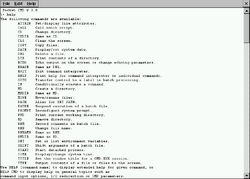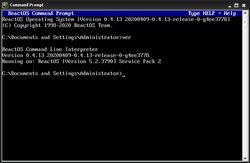Software:cmd.exe
| Other names | Windows Command Processor |
|---|---|
| Developer(s) | Microsoft, IBM, ReactOS contributors |
| Initial release | December 1987 |
| Operating system |
|
| Platform | IA-32, x86-64, ARM (and historically DEC Alpha, MIPS, PowerPC, and Itanium) |
| Predecessor | COMMAND.COM |
| Type | Command-line interpreter |
Command Prompt, also known as cmd.exe or cmd, is the default command-line interpreter for the OS/2,[1] eComStation, ArcaOS, Microsoft Windows (Windows NT family and Windows CE family), and ReactOS[2] operating systems. On Windows CE .NET 4.2,[3] Windows CE 5.0[4] and Windows Embedded CE 6.0[5] it is referred to as the Command Processor Shell. Its implementations differ between operating systems, but the behavior and basic set of commands are consistent. cmd.exe is the counterpart of COMMAND.COM in DOS and Windows 9x systems, and analogous to the Unix shells used on Unix-like systems. The initial version of cmd.exe for Windows NT was developed by Therese Stowell.[6] Windows CE 2.11 was the first embedded Windows release to support a console and a Windows CE version of cmd.exe.[7] The ReactOS implementation of cmd.exe is derived from FreeCOM, the FreeDOS command line interpreter.[2]
Operation
cmd.exe interacts with the user through a command-line interface. On Windows, this interface is implemented through the Win32 console. cmd.exe may take advantage of features available to native programs of its own platform. For example, on OS/2 and Windows, it can use real pipes in command pipelines, allowing both sides of the pipeline to run concurrently. As a result, it is possible to redirect the standard error stream. (COMMAND.COM uses temporary files, and runs the two sides serially, one after the other.)
Multiple commands can be processed in a single command line using the command separator &&.[8]
When using this separator in the Windows cmd.exe, each command must complete successfully for the following commands to execute. For example:
C:\>CommandA && CommandB && CommandC
In the above example, Command B will only execute if Command A completes successfully, and the execution of Command C depends on the successful completion of Command B. To process subsequent commands even if the previous command produces an error, the command separator & should be used.[9] For example:
C:\>CommandA & CommandB & CommandC
On Windows XP or later, the maximum length of the string that can be used at the command prompt is 8191 characters. On earlier versions, such as Windows 2000 or Windows NT 4.0, the maximum length of the string is 2047 characters. This limit includes the command line, individual environment variables that are inherited by other processes, and all environment variable expansions.[10]
Quotation marks are required for the following special characters:[8]
& < > [ ] { } ^ = ; ! ' + , ` ~ [white space]
Internal commands
OS/2
The following is a list of the Microsoft OS/2 internal cmd.exe commands:[11]
- break
- chcp
- cd
- chdir
- cls
- copy
- date
- del
- detach
- dir
- dpath
- echo
- erase
- exit
- for
- goto
- if
- md
- mkdir
- path
- pause
- prompt
- rd
- rem
- ren
- rename
- rmdir
- set
- shift
- start
- time
- type
- ver
- verify
- vol
Windows NT family
The following list of internal commands is supported by cmd.exe on Windows NT and later:[12]
- assoc
- break
- call
- cd
- chdir
- cls
- color
- copy
- date
- del
- dir
- dpath
- echo
- endlocal
- erase
- exit
- for
- ftype
- goto
- if
- keys
- md
- mkdir
- mklink (introduced in Windows Vista)
- move
- path
- pause
- popd
- prompt
- pushd
- rd
- rem
- ren
- rename
- rmdir
- set
- setlocal
- shift
- start
- time
- title
- type
- ver
- verify
- vol
Windows CE
The following list of commands is supported by cmd.exe on Windows CE .NET 4.2,[13] Windows CE 5.0[14] and Windows Embedded CE 6.0:[15]
- attrib
- call
- cd
- chdir
- cls
- copy
- date
- del
- dir
- echo
- erase
- exit
- goto
- help
- if
- md
- mkdir
- move
- path
- pause
- prompt
- pwd
- rd
- rem
- ren
- rename
- rmdir
- set
- shift
- start
- time
- title
- type
In addition, the net command is available as an external command stored in \Windows\net.exe.
ReactOS
The ReactOS implementation includes the following internal commands:[2]
- ?
- alias
- assoc
- beep
- call
- cd
- chdir
- choice
- cls
- color
- copy
- ctty
- date
- del
- delete
- delay
- dir
- dirs
- echo
- echos
- endlocal
- erase
- exit
- for
- free
- goto
- history
- if
- memory
- md
- mkdir
- mklink
- move
- path
- pause
- popd
- prompt
- pushd
- rd
- rmdir
- rem
- ren
- rename
- replace
- screen
- set
- setlocal
- shift
- start
- time
- timer
- title
- type
- ver
- verify
- vol
Comparison with COMMAND.COM
On Windows, cmd.exe is mostly compatible with COMMAND.COM but provides the following extensions over it:
- More detailed error messages than the blanket "Bad command or file name" (in the case of malformed commands) of COMMAND.COM. In OS/2, errors are reported in the chosen language of the system, their text being taken from the system message files. The HELP command can then be issued with the error message number to obtain further information.
- Supports using of arrow keys to scroll through command history. (Under DOS this function was only available under DR DOS (through HISTORY) and later via an external component called DOSKEY.)
- Adds rotating command-line completion for file and folder paths, where the user can cycle through results for the prefix using the , and for reverse direction.
- Treats the caret character (^) as the escape character; the character following it is to be taken literally. There are special characters in cmd.exe and COMMAND.COM (e.g. "<", ">" and "|") that are meant to alter the behavior of the command line processor. The caret character forces the command line processor to interpret them literally.
- Supports delayed variable expansion with
SETLOCAL EnableDelayedExpansion, allowing values of variables to be calculated at runtime instead of during parsing of script before execution (Windows 2000 and later), fixing DOS idioms that made using control structures hard and complex.[16] The extensions can be disabled, providing a stricter compatibility mode.
Internal commands have also been improved:
- The DELTREE command was merged into the RD command, as part of its /S switch.
- SetLocal and EndLocal commands limit the scope of changes to the environment. Changes made to the command line environment after SetLocal commands are local to the batch file. EndLocal command restores the previous settings.[17]
- The Call command allows subroutines within batch file. The Call command in COMMAND.COM only supports calling external batch files.
- File name parser extensions to the Set command are comparable with C shell.[further explanation needed]
- The Set command can perform expression evaluation.
- An expansion of the For command supports parsing files and arbitrary sets in addition to file names.
- The new PushD and PopD commands provide access past navigated paths similar to "forward" and "back" buttons in a web browser or File Explorer.
- The conditional IF command can perform case-insensitive comparisons and numeric equality and inequality comparisons in addition to case-sensitive string comparisons. (This was available in DR-DOS, but not in PC DOS or MS-DOS.)
See also
References
- ↑ "Notes on using the default OS/2 command processor (CMD.EXE)". http://www.tavi.co.uk/os2pages/cmd.html.
- ↑ 2.0 2.1 2.2 "reactos/reactos". December 4, 2021. https://github.com/reactos/reactos.
- ↑ "Command Processor Shell (Windows CE .NET 4.2)". June 30, 2006. https://docs.microsoft.com/en-us/previous-versions/windows/embedded/ms879823(v%3dmsdn.10).
- ↑ "Command Processor Shell (Windows CE 5.0)". September 14, 2012. https://docs.microsoft.com/en-us/previous-versions/windows/embedded/aa453925(v%3dmsdn.10).
- ↑ "Command Processor Shell (Windows Embedded CE 6.0)". 2012. https://docs.microsoft.com/en-us/previous-versions/windows/embedded/ee499728(v%3dwinembedded.60).
- ↑ Showstopper! The Breakneck Race to Create Windows NT and the Next Generation at Microsoft. The Free Press. 1994. ISBN 0-02-935671-7. https://archive.org/details/showstopperbreak00zach.
- ↑ Douglas McConnaughey Boling (2001). Programming Microsoft Windows CE (2nd ed.). Microsoft Press. ISBN 978-0735614437.
- ↑ 8.0 8.1 "cmd". September 12, 2023. https://docs.microsoft.com/en-us/windows-server/administration/windows-commands/cmd.
- ↑ "Command Redirection, Pipes - Windows CMD - SS64.com". https://ss64.com/nt/syntax-redirection.html.
- ↑ Command prompt (Cmd.exe) command-line string limitation
- ↑ Microsoft Operating System/2 User's Reference. Microsoft. 1987. http://www.os2museum.com/wp/wp-content/uploads/2011/12/1987-Oct-OS2-1.0-Users_Reference.pdf.
- ↑ Windows NT Shell Scripting. Macmillan Technical Publishing. 1998. ISBN 978-1578700479. https://archive.org/details/windowsntshellsc0000hill.
- ↑ "Command Processor Commands (Windows CE .NET 4.2)". June 30, 2006. https://docs.microsoft.com/en-us/previous-versions/windows/embedded/ms879786(v=msdn.10).
- ↑ "Command Processor Commands (Windows CE 5.0)". September 14, 2012. https://docs.microsoft.com/en-us/previous-versions/windows/embedded/ms907227(v=msdn.10).
- ↑ "Command Processor Commands (Windows Embedded CE 6.0)". January 5, 2012. https://docs.microsoft.com/en-us/previous-versions/windows/embedded/ee505427(v=winembedded.60).
- ↑ "Windows 2000 delayed environment variable expansion". Windows IT Pro. http://windowsitpro.com/windows/jsi-tip-3240-windows-2000-delayed-environment-variable-expansion.
- ↑ "Setlocal". TechNet. Microsoft. September 11, 2009. https://technet.microsoft.com/en-us/library/bb491001.aspx.
Further reading
- David Moskowitz; David Kerr (1994). OS/2 2.11 Unleashed (2nd ed.). Sams Publishing. ISBN 978-0672304453.
- Stanek, William R. (2008). Windows Command-Line Administrator's Pocket Consultant (2nd ed.). Microsoft Press. ISBN 978-0735622623.
External links
- "Command-line reference A-Z". Microsoft. April 26, 2023. https://docs.microsoft.com/en-us/windows-server/administration/windows-commands/windows-commands.
- "Cmd". Microsoft Windows XP Product Documentation. Microsoft. http://www.microsoft.com/resources/documentation/windows/xp/all/proddocs/en-us/cmd.mspx.
- "Command Prompt: frequently asked questions". windows Help. Microsoft. http://windows.microsoft.com/en-us/windows/command-prompt-faq#1TC=windows-7.
- "An A–Z Index of the Windows CMD command line". SS64.com. https://ss64.com/nt/.
- "Windows CMD.com – Hub of Windows Commands". windowscmd.com. https://windowscmd.com/.
 |





